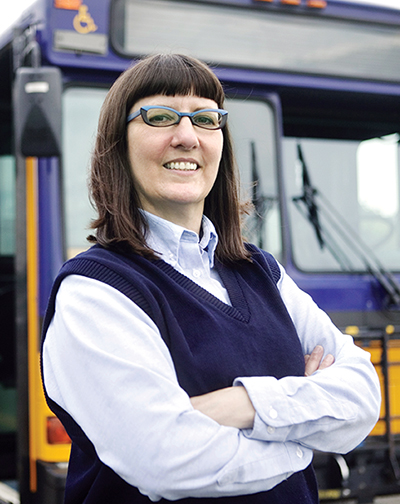
The Southwest of public transit bus companies
By Mary Sue O’Melia
If there is an incident that causes a significant delay in service or inconvenience for your customers, what are your policies and practices for dealing with the customer? How does your agency define good customer service?
Poor customer service examples
In the past month, I have twice experienced delays on the first leg of air travel resulting in a missed connection and an unplanned mid-trip overnight stay. Two separate airlines – United Bad and American Worse.
In both cases, weather at the destination terminal was the reason for the initial delay. Equipment issues and a flight attendant decision to have an irate customer removed from the plane further contributed to late departures. In one case, lack of employee empowerment to hold the door on the last flight of the day resulted in 30 customers missing their connection. Neither company paid for hotel accommodations; weather is not the airlines’ fault and the other company admitted fault but ran out of vouchers – there may be some cots set out in Terminal K.
I could not help thinking, “What would Southwest do in the same situation?” I am fairly certain that whatever they did I would have been less annoyed – Southwest employees are just so polite and upbeat.
 Good customer service starts at the top
Good customer service starts at the top
As I sit in Chicago O’Hare at 2 a.m. pondering the meaning of customer service, I started thinking about public transit and how important the employees are in ensuring customer satisfaction. The attitude of customer service and doing what it takes to do right by the customers is a philosophy and core value. Some companies have it and some do not. Southwest and Nordstroms get it. Which transit agencies fall into the same class?
It is a corporate philosophy that must be constantly rewarded, reinforced and encouraged. When it is working, the customer definitely has a better experience and the employees seem happier too. When was the last time your agency or department rewarded outstanding customer service? Does your agency recognize real-time operational decisions that avert or at least alleviate a customer service nightmare?
This is a column on transit information technology, so what does this tirade have to do with technology?
Using technology to improve the customer experience
Transit technology provides a set of tools that, if utilized correctly and maintained, can enhance the customer experience. For example, Automatic Vehicle Location (AVL) technology can provide real-time information to dispatch for corrective action, real-time information to customers about schedule adherence, and information that can be reviewed after the fact to improve schedules and identify drivers who require coaching (or drivers to reward for good schedule adherence).
Other examples include Automated Passenger Counting (APC) and Automated Fare Systems (AFS) technologies that can reduce the amount of time to board passengers, allowing drivers to pay attention to safe driving and taking the time to smile or at least nod as customers board the bus. Smart cards can provide a significant improvement in payment options and ease of payment, assuming the technology works. In-vehicle diagnostic equipment to reduce roadcalls, apps to tell customers when the next bus is arriving, online information for trip-planning, and Wi-Fi on commuter buses are technologies that can help improve the customer experience.
Technology and information systems can also tell us when things are not working so well or are outstanding. Customer comments, route ridership and farebox revenues all provide information about what customers think of transit service.
As companies, do we invest in technology to improve the customer experience? Do we include safety as well as comfort and convenience in our definition of what we are trying to provide? Do we collect data and spend public funds on systems so that we have information to make better decisions regarding resource allocation and to develop strategies to improve customer service?
Conclusion
All this new technology is wonderful. We have the tools to help monitor and improve customer service. However, if the organization and its people are not polite and helpful, then the technology will not matter. You cannot paint a smiley face on the farebox and call it customer service.
Mary Sue O’Melia is president of TransTrack Systems®, Inc., a business intelligence solution that transforms volumes of data into meaningful information for transportation managers and executives to use in planning, strategizing and ensuring optimal performance. Visit TransTrack Systems® at: www.transtrack.net.
